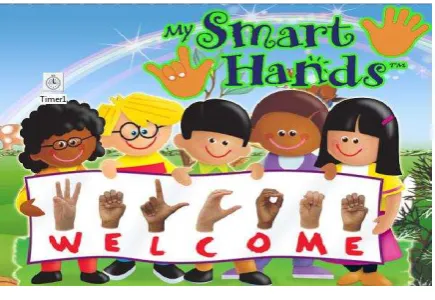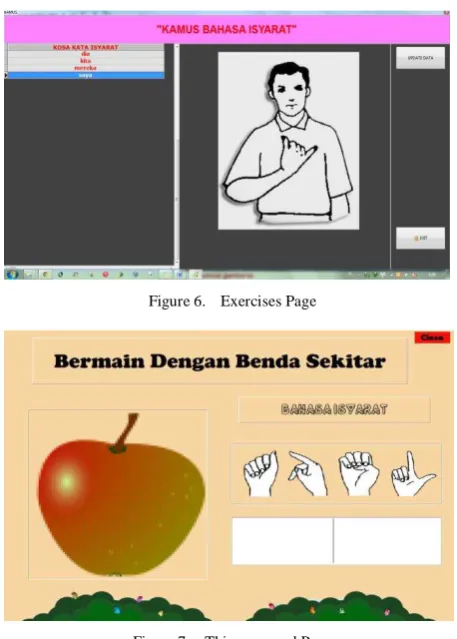Learning Support Application of Gesture Language for Mute
and Deaf
Case Study in
SLB-B YRTRW (Yayasan Rehabilitasi Anak Tuna Rungu Wicara) SURAKARTA
Aris Rakhmadi, Anwar Dwi Harnanto, Fajar Suryawan
Informatics Engineering, Communication and Informatics Faculty, Universitas Muhammadiyah Surakarta Jalan Ahmad Yani Tromol Pos 1 Pabelan Kartasura.Surakarta, Jawa Tengah, Indonesia
Abstract— The communication media of deaf and mute based on SIBI seems ineffective because both educator and learner still lack of memorized gesture vocabulary and have to look for the vocabulary manually in the dictionary. Therefore, the need of electronic dictionary for mute and deaf is necessary. The goal of this research is to create a teaching learning application of gesture language for mute and deaf. The application covers alphabetic, number, day, month, money, and time vocabulary recognition. The research carried out the questionnaire to evaluate the feedback from both educator and learner. The application is easy to operate, effective and efficient in use. 67% learners stated that the display of the application is easy to understand and the other 33% learners stated disagree.
Keywords-mute; deaf; gesture; language; communication; use case
I. INTRODUCTION
Gesture language is a communication tool uses body (hand) language and mouth motion to communicate with deaf and mute [1]. Gesture language have been standardized and named as SIBI (Sistem Isyarat Bahasa Indonesia- Indonesian Language Gesture System). SIBI is a media to help to communicate among deaf and mutes in wider society [2].
The existence of SIBI is a systematic motion pattern of finger, hand and other motions which illustrates Indonesian words. Nowadays, SIBI is used as a teaching learning method based on natural communication approach. However, the communication based on SIBI seems ineffective because both teacher and student still lack of memorized gesture word language and have to search the word manually in the dictionary [3]. Therefore, the need of electronic dictionary for mute and deaf is necessary. The dictionary consists of systematic list of finger, hand, and other motion which illustrated Indonesian word to help understanding gesture language.
The objective of this research is to create a teaching learning application of gesture language for mute and deaf. The expectation of designing this application is to fasten mute and deaf children in understanding the gesture language.
II. REQUIREMENT ANALYSIS
Requirement Analysis is a detail necessity from both users and programmers, which is consists of the need of reference study, software and hardware.
A. Reference Requirement
Reference requirement analysis needed by user is various motions to recognize gesture language as in the following items [5].
Alphabetic Recognition: The image of alphabetic in gesture language from A to Z.
Number Recognition: The figure of number in gesture language from zero to ten.
Day Recognition: The figure of daytime in gesture language from Sunday to Saturday.
Month Recognition: The image of month name in gesture language from January to December.
Money Identification: The figure of money in gesture language such as one hundred, two hundred.
Time Recognition: The figure of clock in gesture language.
Things around: Various figures of things around us in gesture language.
B. Hardware Requirement
The following list is the specification of Personal Computer which is used in this research.
Processor Intel Core i3-350M, 2.26 GHz
Hardisk 320 GB
Windows 7 Operating System
Free Pascal lazarus
Lazarus zeos Components
Xampp
Adobe Photoshop
CITACEE 2013 ISSN: 2338-5154
III. UMLDESIGN(UNIFIED MODELLING LANGUAGE) UML Design consists of Use Case according to requirement analysis. The Use case contains of use case diagram, actor definition and use case definition.
Figure 1. Use Case Diagram
Use case diagram is to illustrate the service given to users. The users of this application are educator and learner as operators. Users as operator are allowed to access all pages in the application and also able to do the exercises. However the users are not allowed to modify both source study and exercises.
Table I illustrates the service given to the users as operators in gesture language application.
TABLE I. ACTOR DEFINITION
No. Actor Description
1. Operator (educator or learner)
A person who is allowed to access teaching learning application, open all course study, add new words, and complete the exercises in the application.
Table II gives an illustration of use case definition which is consist of source study and exercises.
TABLE II. USE CASE DEFINITION
No. Use Case Description
1. Source Study of Gesture Language
User is allowed to access source study which is consist of alphabetic, numeric, day, month, money, time and thing around recognition.
2. Exercises User is allowed to perform exercises provided in this application.
IV. RESULT AND ANALYSIS
A. Research Product
The product of this research is a teaching learning application.
Figure 2. Homepage of the Application
Homepage is the first page displayed which followed by the next page (splash page).
Figure 3. Main Menu
Main menu consists of some button to access the selection page. The buttons are menu belajar, kamus, edugame, about, and exit. Figure IV illustrates the display of menu belajar form.
Figure 4. The Page of Menu Belajar
The page of menu belajar consists of alphabetic, number, day, month, money, and time push button. These pages consist of alphabetic recognition from a to z, number from 1 to 20, days from Sunday to Saturday, months from january to december, and also time recognition. Figure 5 shows the display of alphabetic recognition page.
CITACEE 2013 ISSN: 2338-5154
Figure 5. Alphabetic Recognition Page
Alphabetic recognition page consist of figure of word illustrator and gesture language in the left-side.
Figure 6. Exercises Page
Figure 7. Things around Page
Things around page consist of objects around in gesture language which user has to write the present object.
B. Questioner Analysis
Questioner is used to identify the user satisfaction to the application. The sample of the questioner consists of two educators and six learners. The performance of the program based on educators indicated that:
50% educator stated strongly agrees that learner become more familiar about computer and 50% educator stated agree.
50% educator stated strongly agrees that learner become more familiar with gesture language and 50% educator stated agree.
100% educator stated agrees that learner become more responsive to the gesture language.
100% educator stated agrees that learner become more familiar with gesture edugame.
50% educator stated agree that learner become more recognizable with the gesture word in the dictionary and 50% educator stated disagree.
Figure 8. Learner Scoring to the Application
Figure 8 shows the learner scoring to the application. The performance of the application based on the learners indicated that:
67% learners stated strongly agree that the display of the application is interesting, and the other 33% learners stated agree.
17% learner stated strongly agrees that the interface of the application is clear, 67% agree, and the other 17% disagree.
50% learners stated agree and 50% learners disagree that the application is effective and efficient.
100% learners stated agree that the application is easy to operate.
67% learners stated that the display of the application is easy to understand and the other 33% learners stated disagree.
V. CONCLUSION AND SUGGESTION
According to design, creation, and implementation of the teaching learning application, the research can be concluded that:
a. The teaching learning application of gesture language accomplished as a supporting tool which is consist of alphabet, number, day, month, and money recognition. The application is also provided by exercises to evaluate the student assessment.
b. According to questionnaire result, the application is easy to operate, effective and efficient in use. 67% learners stated that the display of the
CITACEE 2013 ISSN: 2338-5154
application is easy to understand and the other 33% learners stated disagree.
In the future, the next research needs a development based on user and programmer experiences. It is necessary to add more vocabularies to enhance the electronic dictionary.
The teaching learning application of gesture language application is as supporting tool and not as primary tool to learn gesture language. It is because that gesture language is too wide in every discussion and need wider development of the program. The existence of educators or parents is necessary to give and help learner better and brighter explanation.
ACKNOWLEDGMENT
Thanks to Allah SWT, the only one god, the most merciful until the writers are able to accomplish this paper. The writers have tried to complete this paper properly; however we know that it still needs more improvement. Therefore, we expect that the readers would like to offer any advices and evaluations to improve it and get better. Thanks also to all academic society of
Univesitas Muhammadiyah Surakarta who gave us the opportunity to learn together and maintain a valuable academic environment to study and to share each other.
REFERENCES
[1] Gunawan, Imas A.R. 1992. Kamus Dasar Laras Isyarat Bahasa Indonesia. Jakarta: Yayasan Pendidikan Zinna.
[2] Hadi, Purwaka. 2007. Komunikasi Aktif Bagi Tunanetra aktifitas dalam pembelajaran pada sistem pendidikan inklusif. Jakarta : Departemen Pendidikan Nasional .
[3] Sadjaah,Edha. 2005. Pendidikan bahasa bagi Anak Gangguan pendengaran Dalam Keluarga. Jakarta : Direktorat Jendral Pendidikan Nasional.
[4] Suparno, dkk. Pendidikan berkebutuhan Khusus. Bnajarmasin : Dinas pendidikan Provinsi Kalimantan Selatan.
[5] Wardhani IGAK. 2007. Pengantar Pendidikan Luar Biasa. Jakarta : Universitas terbuka.
[6] Winarsih, murni. 2007. Pendidkan bahas bagi Anak Gangguan pendengaran Dalam Keluarga. Jakarta : Direktorat Jendral Pendidikan Nasional.
[7] Yayasan Karya Mulya. 1985. Tata isyarat Bahasa Indonesia. Surabaya
CITACEE 2013 ISSN: 2338-5154

